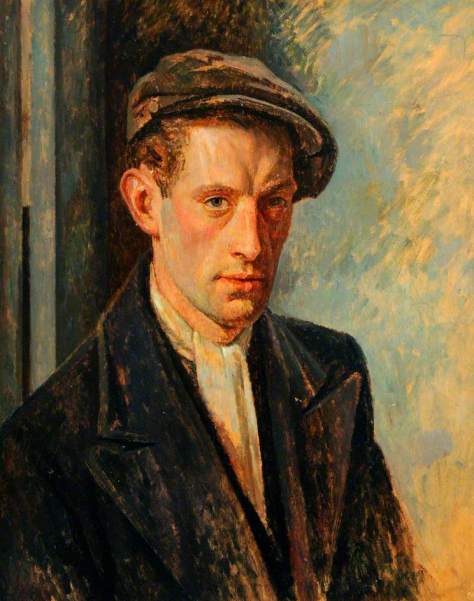


Emma Barker continues her commentary on Ben Nicholson and Barbara Hepworth and their close knit community of English Avant- Garde artists in the 1930’s.
” By the late 1930’s a close knit Avant Garde community was established in Hampstead North London . Its core was formed by Hepworth , Nicholson and Moore”. [1].
” This community was further swelled by the arrival of foreign exiles among them Russian Sculptor Naum Gabo in 1936 and Mondrian in 1938″. [2].
The group called Circle believed its role was to propagate Modern abstract art.
” Like Unit 1 Circle sought to reaffirm a commitment to the modern to promote Modern art to a domestic audience and to locate the British Avant- garde in an international context”.[3].
” After Mondrian the painter given most prominence in the Circle was Nicholson who was represented by examples of white relief that are widely considered to be his most significant contribution to the European Modern Movement“[4].







Barker notes the contribution of Anthony Blunt the Courtaulds and Queen’s art Historian who was also a Stalinist agent together with Philby , Burgess, Maclean and others who worked as Stalinist agents during the period of the 2nd world war.
Burgess was a recognised Art historian who had written a very good account of the Classical French artist Nicholas Poussin.
” Anthony Blunt once (the curator of the Queen’s pictures until he was exposed by Margaret Thatcher in 1979) observed that the gradual rapproachment between art and life made it possible for intellectuals to take an interest in Communism (Stalinism) as well as Cubism had had little effect on British artists”. [5]
” Blunt commented The habit of abstraction is so ingrained that it is difficult to break. It requires a struggle for these artists to burst through their own cubes and cylinders and come back to a consciousness of life”.[6].
Barker now considers the comments of Bernal a noted scientist but steeped in the British Stalinist tradition.
” The problem was most clearly stated by Bernal a committed Communist (Stalinist) but one who did not believe that the answer lay in in sacrificing artistic integrity to Revolutionary purpose”. [7].
[8].






Barker concludes demonstrating the abstraction of the thirties work was highlighted in the late 20th Century with a number of retrospectives.
” Some sense of the status that they respectively acquired is given by the locations of the major retrospectives devoted to the work of each in the Late 20th Century”. [9].
Frances Spalding continues her commentary on the work of the two main surrealists in Britain Ronald Penrose and David Gascoyne .
” The two people chiefly responsible for bringing surrealism to England were the artist and collector Ronald Penrose ( 1900-84) and the poet David Gascoyne “. [10].
” What caused the movement to collapse in England however was not War but Andre Breton’s attempt to exact greater political allegiance from the British Contingent”. [11].
Spalding was absolutely correct here. English Surrealism was to remain a very middle class and a petit bourgeois movement ignoring the great political developments in France around Breton and the early Trotskyist movement who under the guidance of Leon Trotsky would issue a call for Independent revolutionary art in opposition to Stalinist State controlled Social realism art.
” During the winter of 1938-9 the London bulletin carried the Manifesto towards an Independent revolutionary art , although signed by Breton and Mexican artist Diego Riveria (the Great Mexican Muralist). It was written by Breton in collaboration with Leon Trotsky”. [12].






Spalding continues with her narrative of debates and discussions among artists in the 1930’s.
” In March 1938 at a debate on realism versus Surrealism the surrealists came into conflict with two members of the Euston Road School”.[13].
” Behind the existence of this School (Euston road) laying growing dissatisfaction with Modernism in the harsh economic climate of the early 1930’s. Coldstream and Bell in particular were aware that Modern art was failing to reach a lay audience”.[14].
Spalding explains the Social Realism work of Bolton that did engender some sympathy.
” Though the City (Bolton) aroused Bell’s pity and Sympathy he like the other teachers at the Euston Rd school avoided Social realism (Stalinist)art”. [15].
” Artists International association (A Stalinist Front organisation) .The association published a Newsletter with essays by Francis Klingender and Alick West (noted Stalinist Art Historians who declared that Social Realism was real art when what they were supporting was Art lavishly following the Great Leader JV STALIN)”.[16].





As Spalding comments towards the end of this section on Social Realist Art it was Clive Branson a proletarian artist , Member of the Communist Party who will be remembered for his Iconic paintings of the ‘Daily worker’ Daily paper of the Communist Party being sold outside Engineering factories just before the war. Branson himself died during the war but his sister Noreen Branson became a noted Stalinist Historian during the 40’s and 50’s.
” It promoted realism. realism was of course best suited to the proletarian cause and worker-artists such as the coalminers Ashington group were encouraged because life long experience of Industry was felt to bring more realism to a subject”. [17].
” Clive Branson ( 1907-1944) adopted the earnest literalism of a naïve painter for his painting selling the Daily worker outside the Projectile engineering works”. [18].
” It drew attention to the artists role and broadened the Audience for contemporary art ( But it encouraged class compromise and Popular Frontism which has always been the hallmark of Stalinism in its counter revolutionary role)”. [19].
This concludes my study of English art from 1900- 1940.
FOOTNOTES
- ART OF THE AVANT-GARDES -ENGLISH ABSTRACTION -NICHOLSON , HEPWORTH AND MOORE IN THE 1930’s. EMMA BARKER.PG.279
- DITTO.PG.279
- DITTO.PG.280
- DITTO.PG.280
- DITTO.PG.297
- DITTO.PG.297
- DITTO.PG.297
- DITTO.PG.300
- DITTO.PG.301.
- BRITISH ART SINCE 1900:FRANCES SPALDING.PG.116
- DITTO.PG.116
- DITTO.PG.118
- DITTO.PG.118
- DITTO.PG.120
- DITTO.PG.122
- DITTO. PG.122
- DITTO.PG.124
- DITTO.PG.124
- DITTO.PG.125